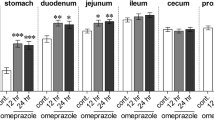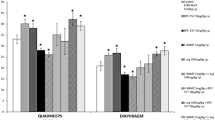Abstract
Hypomagnesemia is the most concerned side effect of proton pump inhibitors (PPIs) in chronic users. However, the mechanism of PPIs-induced systemic Mg2+ deficit is currently unclear. The present study aimed to elucidate the direct effect of short-term and long-term PPIs administrations on whole body Mg2+ homeostasis and duodenal Mg2+ absorption in rats. Mg2+ homeostasis was studied by determining the serum Mg2+ level, urine and fecal Mg2+ excretions, and bone and muscle Mg2+ contents. Duodenal Mg2+ absorption as well as paracellular charge selectivity were studied. Our result showed that gastric and duodenal pH markedly increased in omeprazole-treated rats. Omeprazole significantly suppressed plasma Mg2+ level, urinary Mg2+ excretion, and bone and muscle Mg2+ content. Thus, omeprazole induced systemic Mg2+ deficiency. By using Ussing chamber techniques, it was shown that omeprazole markedly suppressed duodenal Mg2+ channel-driven and Mg2+ channel-independent Mg2+ absorptions and cation selectivity. Inhibitors of mucosal HCO3 − secretion significantly increased duodenal Mg2+ absorption in omeprazole-treated rats. We therefore hypothesized that secreted HCO3 − in duodenum decreased luminal proton, this impeded duodenal Mg2+ absorption. Higher plasma total 25-OH vitamin D, diuresis, and urine PO4 3− were also demonstrated in hypomagnesemic rats. As a compensatory mechanism for systemic Mg2+ deficiency, the expressions of duodenal transient receptor potential melastatin 6 (TRPM6), cyclin M4 (CNNM4), claudin (Cldn)-2, Cldn-7, Cldn-12, and Cldn-15 proteins were enhanced in omeprazole-treated rats. Our findings support the potential role of duodenum on the regulation of Mg2+ homeostasis.








Similar content being viewed by others
References
Abrahamsen B, Vestergaard P (2013) Proton pump inhibitor use and fracture risk—effect modification by histamine H1 receptor blockade. Observational case-control study using National Prescription Data. Bone 57(1):269–271
Agar M, Webster R, Lacey J, Donovan B, Walker A (2004) The use of subcutaneous omeprazole in the treatment of dyspepsia in palliative care patients. J Pain Symptom Manag 28(6):529–531
Agus ZS (1999) Hypomagnesemia. J Am Soc Nephrol 10(7):1616–1622
Allen A, Flemström G (2005) Gastroduodenal mucus bicarbonate barrier: protection against acid and pepsin. Am J Physiol Cell Physiol 288(1):C1–C19
Ben-Ghedalia D, Tagari H, Zamwel S, Bondi A (1975) Solubility and net exchange of calcium, magnesium and phosphorus in digesta flowing along the gut of the sheep. Br J Nutr 33(1):87–94
Cundy T, Dissanayake A (2008) Severe hypomagnesemia in long-term users of proton-pump inhibitors. Clin Endocrinol 69:338–341
Cundy T, Mackay J (2011) Proton pump inhibitors and severe hypomagnesemia. Curr Opin Gastroenterol 27(2):180–185
Danziger J, William JH, Scott DJ, Lee J, Lehman LW, Mark RG, Howell MD, Celi LA, Mukamal KJ (2013) Proton-pump inhibitor use is associated with low serum magnesium concentrations. Kidney Int 83(4):692–699
de Baaij JHF, Hoenderop JG, Bindels RJM (2015) Magnesium in man: implications for health and disease. Physiol Rev 95(1):1–46
Doroszewicz J, Waldegger P, Jeck N, Seyberth H, Waldegger S (2005) pH dependence of extracellular calcium sensing receptor activity determined by a novel technique. Kidney Int 67(1):187–192
Epstein M, McGrath S, Law F (2006) Proton-pump inhibitors and hypomagnesemic hypoparathyroidism. N Engl J Med 355:1834–1836
Evenepoel P (2001) Alteration in digestion and absorption of nutrients during profound acid suppression. Best Pract Res Clin Gastroenterol 15:539–551
Fujita H, Chiba H, Yokozaki H, Sakai N, Sugimoto K, Wada T, Kojima T, Yamashita T, Sawada N (2006) Differential expression and subcellular localization of claudin-7, −8, −12, −13, and −15 along the mouse intestine. J Histochem Cytochem 54:933–944
Fujita H, Sugimoto K, Inatomi S, Maeda T, Osanai M, Uchiyama Y, Yamamoto Y, Wada T, Kojima T, Yokozaki H, Yamashita T, Kato S, Sawada N, Chiba H (2008) Tight junction proteins claudin-2 and -12 are critical for vitamin D-dependent Ca2+ absorption between enterocytes. Mol Biol Cell 19:1912–1921
Furuse M, Tsukita S (2006) Claudins in occluding junctions of humans and flies. Trends Cell Biol 16(4):181–188
Günzel D, Yu AS (2013) Claudins and the modulation of tight junction permeability. Physiol Rev 93(2):525–569
Hess MW, de Baaij JHF, Gommers LMM, Hoenderop JGJ, Bindels RJM (2015) Dietary inulin fibers prevent proton-pump inhibitor (PPI)-induced hypocalcemia in mice. PLoS One 10(9):e0138881
Heijnen AM, Brink EJ, Lemmens AG, Beynen AC (1993) Ileal pH and apparent absorption of magnesium in rats fed on diets containing either lactose or lactulose. Br J Nutr 70(3):747–756
Hou J, Renigunta A, Gomes AS, Hou M, Paul DL, Waldegger S, Goodenough DA (2009) Claudin-16 and claudin-19 interaction is required for their assembly into tight junctions and for renal reabsorption of magnesium. Proc Natl Acad Sci U S A 106(36):15350–15355
Ikari A, Okude C, Sawada H, Sasaki Y, Yamazaki Y, Sugatani J, Degawa M, Miwa M (2008) Activation of a polyvalent cation-sensing receptor decreases magnesium transport via claudin-16. Biochim Biophys Acta 1778(1):283–290
Im WB, Blakeman DP, Davis JP (1985) Irreversible inactivation of rat gastric (H+-K+)-ATPase in vivo by omeprazole. Biochem Biophys Res Commun 126(1):78–82
Kladnitsky O, Rozenfeld J, Azulay-Debby H, Efrati E, Zelikovic I (2015) The claudin-16 channel gene is transcriptionally inhibited by 1,25-dihydroxyvitamin D. Exp Physiol 100(1):79–94
Lameris ALL, Hess MW, van Kruijsbergen I, Hoenderop JGJ, Bindels RJM (2013) Omeprazole enhances the colonic expression of the Mg2+ transporter TRPM6. Pflugers Arch Eur J Physiol 465(11):1613–1620
Lameris AL, Nevalainen PI, Reijnen D, Simons E, Eygensteyn J, Monnens L, Bindels RJ, Hoenderop JG (2015) Segmental transport of Ca2+ and Mg2+ along the gastrointestinal tract. Am J Physiol Gastrointest Liver Physiol 308(3):G206–G216
Luk CP, Parsons R, Lee YP, Hughes JD (2013) Proton pump inhibitor-associated hypomagnesemia: what do FDA data tell us? Ann Pharmacother 47(6):773–780
Maggio M, Lauretani F, Ceda GP, De Vita F, Bondi G, Corsonello A, Cattabiani C, Lattanzio F, Ruggiero C, Nouvenne A, Meschi T, Bandinelli S, Ferrucci L (2013) Use of proton pump inhibitors is associated with lower trabecular bone density in older individuals. Bone 57(2):437–442
Mejia A, Kraft WK (2009) Acid peptic diseases: pharmacological approach to treatment. Expert Rev Clin Pharmacol 2(3):295–314
Mertz-Nielsen A, Hillingsø J, Bukhave K, Rask-Madsen J (1996) Omeprazole promotes proximal duodenal mucosal bicarbonate secretion in humans. Gut 38:6–10
Nugent SG, Kumar D, Rampton DS, Evans DF (2001) Intestinal luminal pH in inflammatory bowel disease: possible determinants and implications for therapy with aminosalicylates and other drugs. Gut 48:571–577
Patterson Burdsall D, Flores HC, Krueger J, Garretson S, Gorbien MJ, Iacch A, Dobbs V, Homa T (2013) Use of proton pump inhibitors with lack of diagnostic indications in 22 Midwestern US skilled nursing facilities. J Am Med Dir Assoc 14(6):429–432
Quamme GA (2008) Recent developments in intestinal magnesium absorption. Curr Opin Gastroenterol 24(2):230–235
Quinn R (2005) Comparing rat’s to human ’s age: how old is my rat in people years? Nutrition 21(6):775–777
Rondón LJ, Rayssiguier Y, Mazur A (2008) Dietary inulin in mice stimulates Mg2+ absorption and modulates TRPM6 and TRPM7 expression in large intestine and kidney. Magnes Res 21(4):224–231
Rude RK, Gruber HE (2004) Magnesium deficiency and osteoporosis: animal and human observations. J Nutr Biochem 15(12):710–716
Serfaty-Lacrosniere C, Wood RJ, Voytko D, Saltzman JR, Pedrosa M, Sepe TE, Russell RR (1995) Hypochlorhydria from short-term omeprazole treatment does not inhibit intestinal absorption of calcium, phosphorus, magnesium or zinc from food in humans. J Am Coll Nutr 14(4):364–368
Sengoku A, Inai T, Shibata Y (2008) Formation of aberrant TJ strands by overexpression of claudin-15 in MDCK II cells. Histochem Cell Biol 129(2):211–222
Serra S, Jani PA (2006) An approach to duodenal biopsies. J Clin Pathol 59(11):1133–1150
Shabajee N, Lamb EJ, Sturgess I, Sumathipala RW (2008) Omeprazole and refractory hypomagnesemia. BMJ 337:a425
Schlingmann KP, Weber S, Peters M, Niemann Nejsum L, Vitzthum H, Klingel K, Kratz M, Haddad E, Ristoff E, Dinour D, Syrrou M, Nielsen S, Sassen M, Waldegger S, Seyberth HW, Konrad M (2002) Hypomagnesemia with secondary hypocalcemia is caused by mutations in TRPM6, a new member of the TRPM gene family. Nat Genet 31:166–170
Swaminathan R (2003) Magnesium metabolism and its disorders. Clin Biochem Rev 24(2):47–66
Thongon N, Nakkrasae LI, Thongbunchoo J, Krishnamra N, Charoenphandhu N (2008) Prolactin stimulates transepithelial calcium transport and modulates paracellular permselectivity in Caco-2 monolayer: mediation by PKC and ROCK pathways. Am J Physiol Cell Physiol 294:C1158–C1168
Thongon N, Krishnamra N (2011) Omeprazole decreases magnesium transport across Caco-2 monolayers. World J Gastroenterol 17(12):1574–1583
Thongon N, Krishnamra N (2012) Apical acidity decreases inhibitory effect of omeprazole on Mg2+ absorption and claudin-7 and -12 expression in Caco-2 monolayers. Exp Mol Med 44(11):684–693
Thongon N, Ketkeaw P, Nuekchob C (2014) The roles of acid-sensing ion channel 1a and ovarian cancer G protein-coupled receptor 1 on passive Mg2+ transport across intestinal epithelium-like Caco-2 monolayers. J Physiol Sci 64(2):129–139
Vetter T, Lohse MJ (2002) Magnesium and the parathyroid. Curr Opin Nephrol Hypertens 11(4):403–410
Voets T, Nilius B, Hoefs S, van der Kemp AW, Droogmans G, Bindels RJ, Hoenderop JG (2004) TRPM6 forms the Mg2+ influx channel involved in intestinal and renal Mg2+ absorption. J Biol Chem 279:19–25
Walder RY, Landau D, Meyer P, Shalev H, Tsolia M, Borochowitz Z, Boettger MB, Beck GE, Englehardt RK, Carmi R, Sheffield VC (2002) Mutation of TRPM6 causes familial hypomagnesemia with secondary hypocalcemia. Nat Genet 31:171–174
Wang J, Barbuskaite D, Tozzi M, Giannuzzo A, Sørensen CE, Novak I (2015) Proton pump inhibitors inhibit pancreatic secretion: role of gastric and non-gastric H+/K+-ATPases. PLoS One 10(5):e0126432
Wolf FI, Trapani V, Simonacci M, Mastrototaro L, Cittadini A, Schweigel M (2010) Modulation of TRPM6 and Na+/Mg2+ exchange in mammary epithelial cells in response to variations of magnesium availability. J Cell Physiol 222(2):374–381
Xie J, Sun B, Du J, Yang W, Chen H-C, Overton JD, Runnels LW, Yue L (2011) Phosphatidylinositol 4,5-bisphosphate (PIP2) controls magnesium gatekeeper TRPM6 activity. Sci Rep 1:146
Yamazaki D, Funato Y, Miura J, Sato S, Toyosawa S, Furutani K, Kurachi Y, Omori Y, Furukawa T, Tsuda T, Kuwabata S, Mizukami S, Kikuchi K, Miki H (2013) Basolateral Mg2+ extrusion via CNNM4 mediates transcellular Mg2+ transport across epithelia: a mouse model. PLoS Genet 9(12):e1003983
Yu AS, Enck AH, Lencer WI, Schneeberger EE (2003) Claudin-8 expression in Madin-Darby canine kidney cells augments the paracellular barrier to cation permeation. J Biol Chem 278(19):17350–17359
Acknowledgements
This study was supported by the research grants from the Thailand Research Fund (RSA5680005), Burapha University through National Research Council of Thailand (33/2559), and the Faculty of Allied Health Sciences, Burapha University (AHS08/2558) to N. Thongon. We express our gratitude to Emeritus Prof. Dr. Prasert Sobhon of the Facuty of Allied Health Sciences, Burapha University, for his helpful suggestions and proofreading. We also thank Asst. Prof. Dr. Siriporn Chamniansawat, Ms. Maneerat Sakuntang, Ms. Sariya Ragsanit, Ms. Warintip Wetkama of the Facuty of Allied Health Sciences, Burapha University, Ms. Pornpun Seelaphong of the Microscopic Center, Faculty of Science, Burapha University, and Mr. Sakorn Praiwijarn and Ms. Dokerug Suwanchalong of Medical Laboratory Center, Burapha University Hospital, Burapha University for their excellent technical assistance.
Author contributions
Thongon N designed and performed experiments, analyzed and interpreted the results, wrote and edited the manuscript. Penguy J, Kulwong S, Khongmueang K, and Thongma M performed experiments.
Author information
Authors and Affiliations
Corresponding author
Ethics declarations
Conflict of interest statement
The authors declare no conflicts of interest.
Rights and permissions
About this article
Cite this article
Thongon, N., Penguy, J., Kulwong, S. et al. Omeprazole suppressed plasma magnesium level and duodenal magnesium absorption in male Sprague-Dawley rats. Pflugers Arch - Eur J Physiol 468, 1809–1821 (2016). https://doi.org/10.1007/s00424-016-1905-7
Received:
Revised:
Accepted:
Published:
Issue Date:
DOI: https://doi.org/10.1007/s00424-016-1905-7




